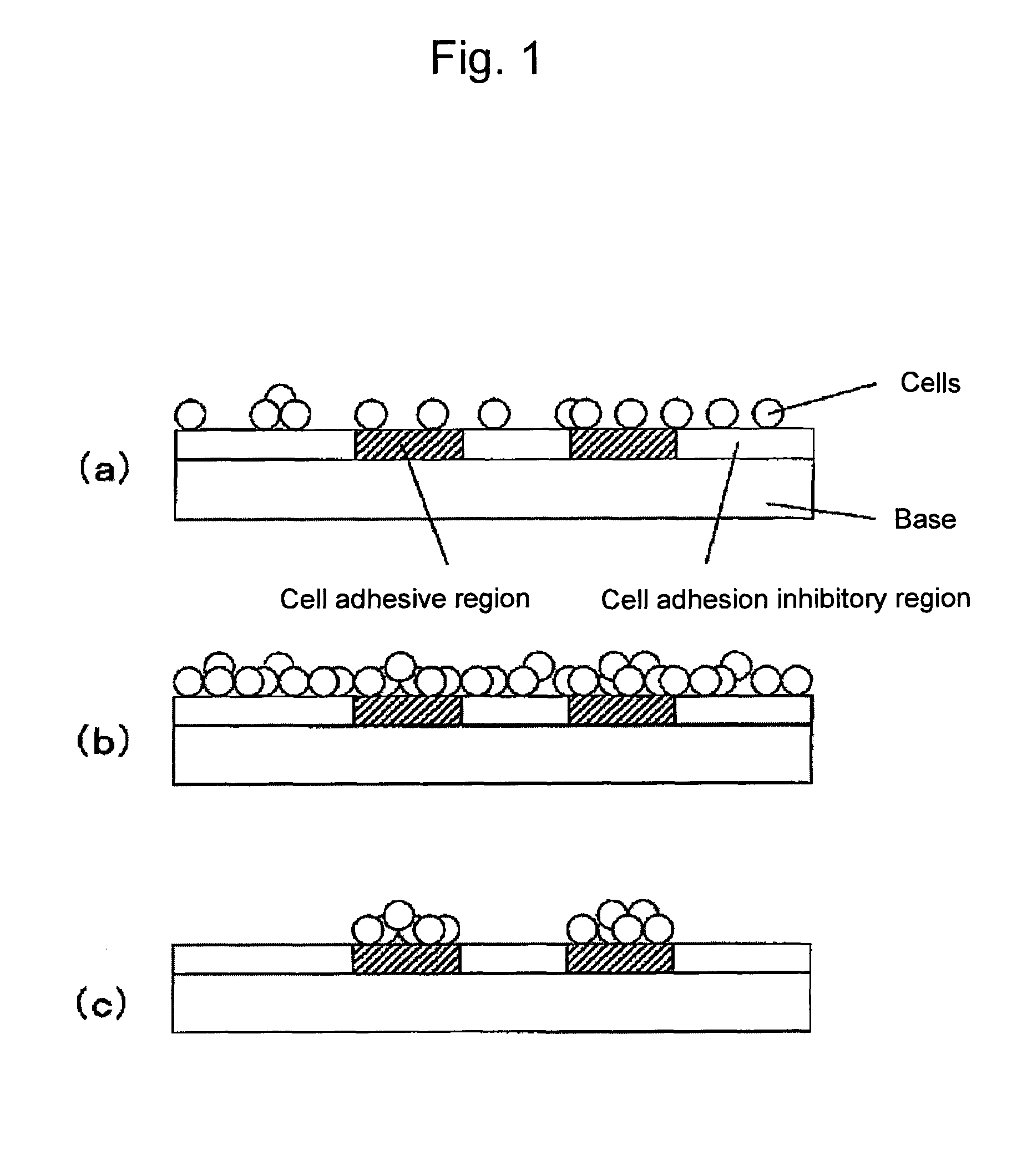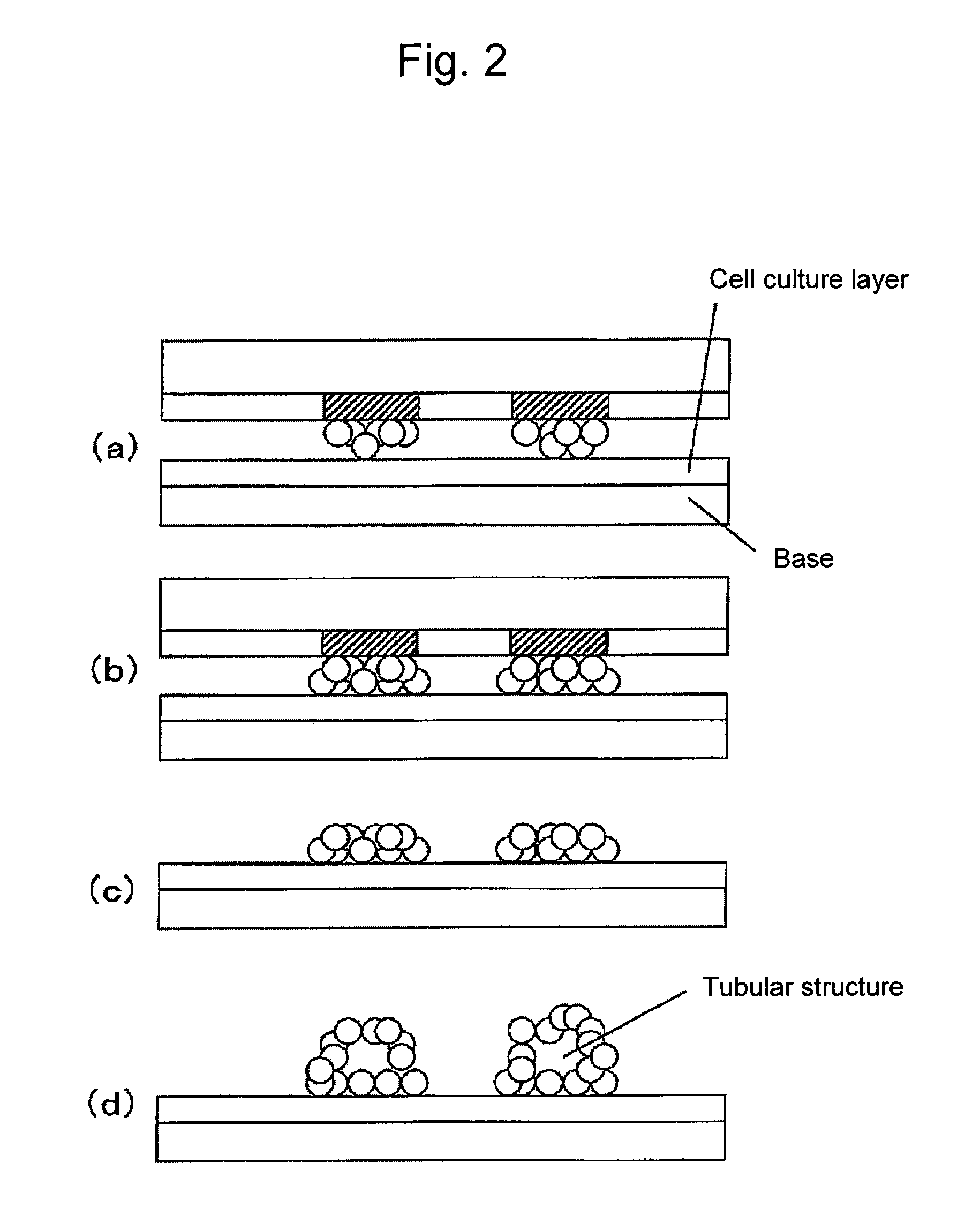Substrate for cell culture
a cell culture and substrate technology, applied in the field of substrate for cell culture, can solve the problems of difficult chemically imparting photosensitivity to a biopolymer, cell culture cannot survive for a long time in a floating state, and sometimes adverse effects of solutions on cell culture, and achieve the effect of high speed
- Summary
- Abstract
- Description
- Claims
- Application Information
AI Technical Summary
Benefits of technology
Problems solved by technology
Method used
Image
Examples
example 1
[0113]First, 39.0 g of toluene and 13.5 g of epoxy silane TSL8350 (manufactured by GE Toshiba Silicones Co., Ltd.) were mixed. While the mixture solution was stirred, a catalyst amount of triethylamine was added. The mixture was further stirred at room temperature for several minutes. A UV washed glass substrate of 10 cm square was soaked in the epoxy silane solution prepared above and allowed to stand still at room temperature for 12 hours. Thereafter, the glass substrate having the underlying layer formed thereon washed with ethanol, followed with water and dried. The average contact angle of water with the surface of the substrate after the film formation was 50.2°.
[0114]While 50 g of tetraethylene glycol was stirred, a catalyst amount of concentrated sulfuric acid was slowly added. The mixture was further stirred at room temperature for several minutes. The epoxylated substrate prepared above was soaked in the tetraethylene glycol solution prepared above. The reaction was perfor...
example 2
[0123]First, 19.5 g of toluene and 6.8 g of epoxy silane TSL8350 (manufactured by GE Toshiba Silicones Co., Ltd.) were mixed. While the mixture was stirred, a catalyst amount of triethylamine was added. The reaction was further stirred at room temperature for several minutes. A UV washed glass substrate of 10 cm square was soaked in the epoxy silane solution prepared above and allowed to stand still at room temperature for 14 hours. Subsequently, the epoxylated glass substrate washed with ethanol followed by water and dried. An average contact angle of water with the surface of the substrate after the film formation was 51.4°.
[0124]While 25 g of tetraethylene glycol (TEG) was stirred, a catalyst amount of concentrated sulfuric acid was slowly added. The mixture was further stirred for several minutes. The epoxylated substrate prepared above was soaked in TEG. The reaction was performed at 80° C. for 15 minutes. After completion of the reaction, the substrate washed well with water a...
example 3
[0129]First, 39.0 g of toluene and 13.5 g of epoxy silane TSL8350 (manufactured by GE Toshiba Silicones Co., Ltd.) were mixed. While the mixture was stirred, 450 μl of triethylamine was added. After the mixture was stirred as it was at room temperature for several minutes, the total amount of the mixture was transferred to a glass plate. Into this, a UV washed glass substrate of 10 cm square was soaked and allowed to stand still at room temperature for 16 hours. Thereafter, the glass substrate washed with ethanol and water and dried with nitrogen blow. In this manner, a thin film containing an epoxy group was formed on the surface of the glass substrate. An average contact angle of water with the substrate surface after the film formation was 48.9°.
[0130]While 50 g of TEG was stirred, 250 μl of concentrated sulfuric acid was added dropwise. After the mixture was further stirred for several minutes, the total amount of the mixture was transferred to a glass plate. Into this, the afor...
PUM
| Property | Measurement | Unit |
|---|---|---|
| thickness | aaaaa | aaaaa |
| thickness | aaaaa | aaaaa |
| thickness | aaaaa | aaaaa |
Abstract
Description
Claims
Application Information
 Login to View More
Login to View More - R&D
- Intellectual Property
- Life Sciences
- Materials
- Tech Scout
- Unparalleled Data Quality
- Higher Quality Content
- 60% Fewer Hallucinations
Browse by: Latest US Patents, China's latest patents, Technical Efficacy Thesaurus, Application Domain, Technology Topic, Popular Technical Reports.
© 2025 PatSnap. All rights reserved.Legal|Privacy policy|Modern Slavery Act Transparency Statement|Sitemap|About US| Contact US: help@patsnap.com


